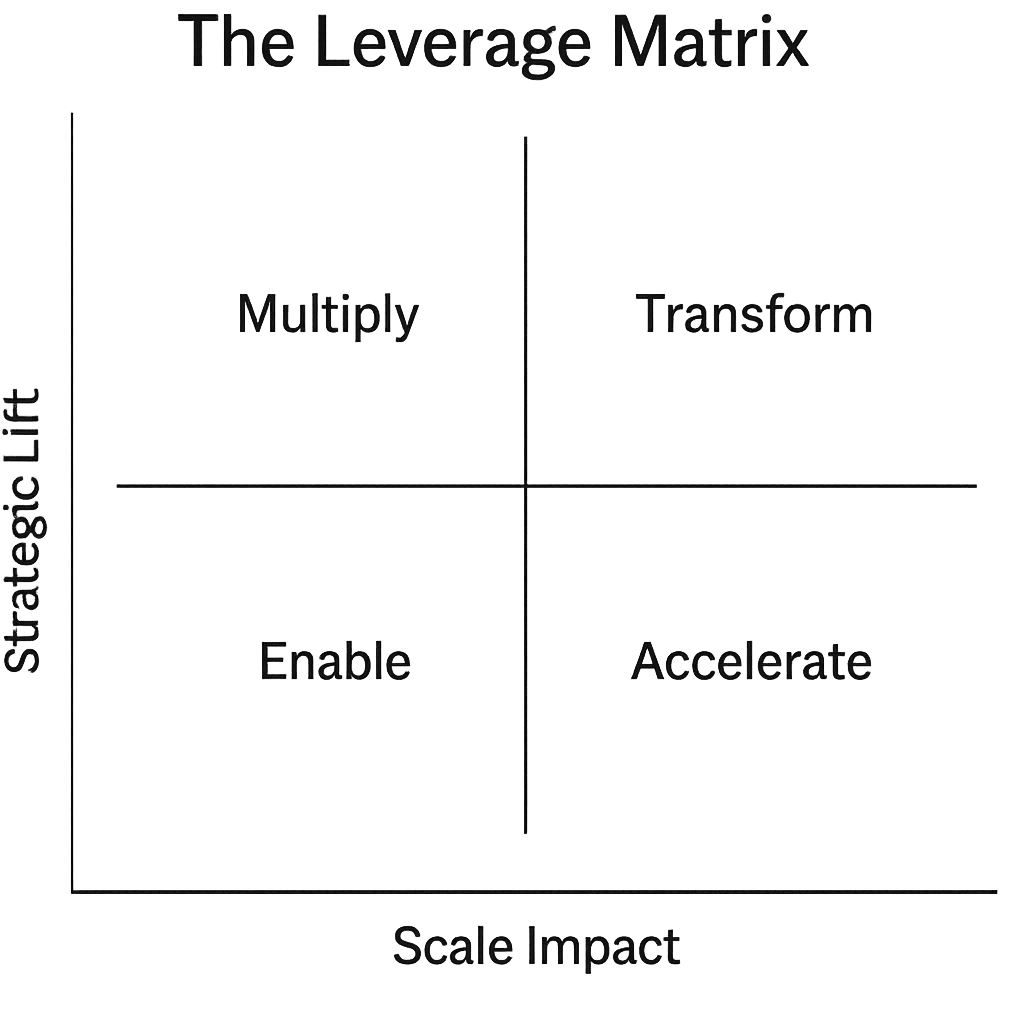Building for Leverage: How Great PMs Design Compounding Products
Why the smartest product teams don’t just ship; they compound.
🎧 Now a Podcast Conversation
This article generated a new episode of The Product Leader’s Playbook, where our AI hosts break down what it really means to build leverage into your product roadmap. They explore the difference between shipping features and compounding value, walk through the Leverage Matrix, and highlight how great PMs unlock long-term momentum instead of chasing short-term wins.
→ 🎙 Listen on Spotify | Listen on Apple Podcasts
“The strength of a man's virtue should not be measured by his special exertions, but by his habitual acts.”
— Blaise Pascal
In product management, we often glorify the high-effort moments: the sprint to MVP, the dazzling launch, the heroic pivot. But the true measure of product leadership does not reside in these bursts of effort. It is found in the quiet, persistent discipline of making compounding decisions. Some features feel impactful simply because they are visible. They took effort. They shipped. But that alone does not make them meaningful.
What separates great product managers from competent ones is not merely the ability to ship features, but the ability to shape the product’s trajectory. Strategic product leaders build for leverage. They make deliberate decisions today that continue to deliver value tomorrow and continue compounding thereafter.
Not every feature deserves equal attention. Some improvements are fleeting and incremental. Others are force multipliers. These features do more than solve a problem; they open new surface area, extend long-term value, and accelerate outcomes for both users and internal teams. This is the fundamental difference between managing a roadmap and designing a compounding product system.
Beyond the MVP
Most of us are trained to value the MVP. Build just enough to prove value, then iterate based on learning. It is a mindset that serves well in the earliest phases of product development. But like all good tools, it becomes problematic when applied universally.
The reality is that MVPs rarely scale. They help you prove an idea, but they do not help you compound impact. Many teams find themselves stuck in MVP mode - optimizing first impressions, polishing UI, responding to feedback, and slowly accumulating marginal gains.
MVPs prove viability. Leverage creates velocity.
Strategic product leaders make a different move. Instead of asking, “What should we build next?” they begin to ask, “What can we build now that will make everything we do afterward easier, faster, or more valuable?” That question reframes your entire approach. It unlocks leverage.
And leverage is not accidental. It must be designed.
The Leverage Matrix: A Mental Model for Strategic Product Impact
When most teams evaluate roadmap options, they use some variation of the effort-versus-impact model. That’s a fine starting point. But it often focuses too heavily on short-term results: user adoption, usability, immediate revenue impact.
Leverage is different. It is not about what happens this quarter. It is about amplifying the product’s potential over time.
Defining the Axes:
Scale Impact refers to how widely a feature’s benefits propagate across users, use cases, customer segments, or even internal systems.
Strategic Lift refers to how much a feature elevates the product’s potential, whether by expanding its capabilities, changing its positioning, or opening new market pathways.
Enable: Foundational functionality - necessary for usage but not differentiating. Think authentication, billing systems, or permissioning.
Accelerate: Features that reduce friction or increase speed of value delivery. Examples include AI-powered shortcuts, optimized workflows, or UX enhancements.
Multiply: Features that extend the core product across personas, platforms, or use cases. Think APIs, integrations, or localization layers.
Transform: Strategic moves that fundamentally change your product’s trajectory. These include marketplace models, extensibility frameworks, or embedded AI copilots.
Leverage is not about what you build next. It's about what makes everything after it more valuable.
A Fictional Scenario: The Shift to Strategic Leverage
Sofia is a product manager at a mid-stage SaaS startup. Her team has just shipped their MVP, a simple collaboration tool designed for remote teams. Early usage metrics were encouraging, but momentum began to stall. Retention was flattening. Engagement was inconsistent. The executive team pushed for quick wins: add a dark mode, build a dashboard, support new views. All useful. None strategic.
Rather than follow the noise, Sofia paused. She stepped back and mapped every feature request onto a leverage matrix. To her surprise, nearly every request landed in the bottom half of the matrix, either foundational or accelerative. Necessary, but not transformative.
She pitched a different idea: a unifying integration layer that would allow customers to seamlessly sync documents and conversations across Slack, Notion, and Google Drive. It would require cross-functional coordination and architectural changes. But if done right, it could extend their value proposition dramatically, turning their product from a standalone tool into an orchestration hub.
They built it. Adoption surged. Usage depth increased. Retention rose. Expansion revenue kicked in as new customer segments came onboard. Sofia’s team hadn’t just shipped a feature. They had built leverage, and their roadmap would never look the same.
Real-World Examples by Quadrant
Enable
Stripe’s API key dashboard: necessary for developer onboarding, but not compounding
Zoom’s SSO login: required for enterprise access, but not value-expanding
Shopify’s billing infrastructure: foundational, but not differentiating
Accelerate
Notion’s AI autocomplete: speeds up writing, but doesn’t expand use cases
Calendly’s timezone detection: reduces friction, not scope
Duolingo’s streak freeze: boosts motivation, not core value
Multiply
Slack’s third-party integrations: embed the product deeper into workflows
Figma’s design systems: expand from users to teams to organizations
Airtable’s scripting and API access: turn a tool into a platform for builders
Transform
Figma’s multiplayer collaboration: reframed design as a team sport
Shopify’s App Store: created a two-sided marketplace and growth engine
Amazon Prime: redefined the customer relationship and purchasing behavior
How to Use the Matrix in Roadmap Planning
Step 1: Categorize
Take your roadmap and plot each feature across the matrix. Ask:
Is this foundational (Enable)?
Does it reduce friction (Accelerate)?
Does it extend product reach (Multiply)?
Does it reframe our product’s role or future (Transform)?
Step 2: Balance
Evaluate the mix based on product maturity:
In early-stage products, a heavy tilt toward Enable and Accelerate features makes sense.
In growth-stage products, the balance should shift toward Multiply.
Mature products should increasingly focus on Transform features that unlock new markets or models.
Step 3: Sequence
Not every feature needs to be built now. The sequence matters.
Build Enable features just in time, not in advance.
Use Accelerate features to address friction at key lifecycle moments.
Invest in Multiply once your core value proposition is validated.
Pursue Transform when the product has momentum and strategic clarity.
Step 4: Communicate
Reframe internal discussions and executive updates using this language. For example:
Instead of saying, “We’re adding localization,” say, “This is a Multiply feature - it extends our reach into new markets while increasing the value of our core product without changing its foundation.”
This not only clarifies your strategic intent, it elevates your influence.
Leverage and Metrics: A Strategic Bridge
Multiply and Transform features do more than feel strategic, they change what is measurable. They introduce new metrics and improve existing ones:
Integration stickiness
Expansion revenue
Ecosystem health
DAU/MAU uplift
Cross-team adoption
If your reporting infrastructure cannot capture these outcomes, you will miss the strategic signals your roadmap is producing. Building for leverage requires instrumentation to match.
Reflection: Designing Products That Pay Dividends
Building for leverage is not simply a tactical prioritization framework, it is a lens on long-term value. The best product managers do not just ship more features. They think in systems. They ask, “What can we build that will multiply everything else we build?”
MVPs are how you start. Leverage is how you scale. The features that matter most are not the ones that deliver instant gratification. They are the ones that shift the slope of the curve. They unlock new usage patterns, new customer segments, or even new business models.
Each roadmap decision is an investment. And over time, the right investments do not just add up. They compound.
“If a feature doesn’t create momentum, it’s just maintenance.”
“MVPs help you start. Leverage helps you scale.”
“Leverage is what turns a roadmap into a strategy.”
Because in product, leverage is not just a bonus. It is the blueprint.
💬 Discussion Points
Which of your current roadmap items fall into each quadrant of the Leverage Matrix?
What is one Multiply or Transform feature you could prioritize this quarter?
How do you currently evaluate feature impact beyond short-term adoption?
🎧 Want to Go Deeper?
This article is discussed in a podcast episode of The Product Leader’s Playbook, streaming everywhere:
🔹 Spotify | 🔹 Apple Podcasts | 🔹 YouTube | 🔹 Amazon Music





